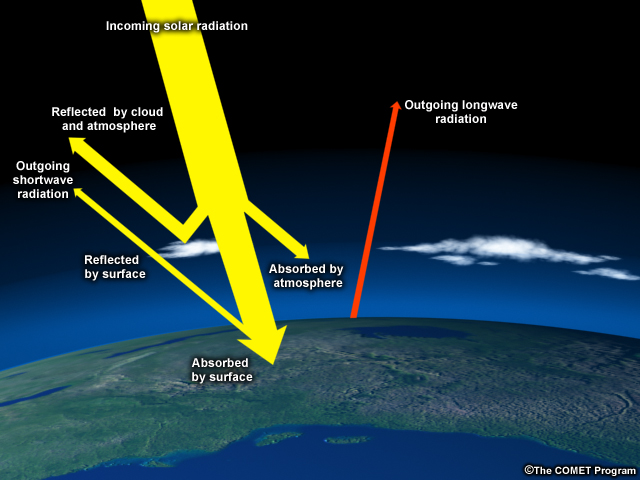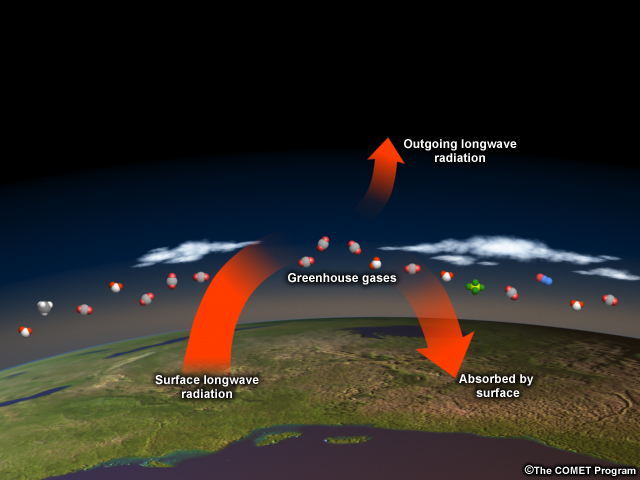Greenhouse Effect

Earth's surface absorbs heat from the sun and then re-radiates it back into the atmosphere and to space.

Much of this heat is absorbed by greenhouse gases, which then send the heat back to the surface, to other greenhouse gas molecules, or out to space. This is commonly called "the Greenhouse Effect" but "the blanket effect" may be more appropriate. Though only 1% of atmospheric gases are greenhouse gases, they are extremely powerful heat trappers. By burning fossil fuels faster and faster, humans are effectively piling on more blankets, heating the planet so much and so quickly that it's hard for Mother Nature and human societies to adapt.
Though carbon dioxide gets the most press, it's certainly not the only greenhouse gas, nor even the most powerful. However, humans produce more of it than any other greenhouse gas, and it's very long-lasting (50-100+ years). In the United States, CO2 comprises more than 80% of total greenhouse gas emissions.
Example of Human-Produced Greenhouse Gases | ||||
| Global Warming Potential (Relative to CO2) | ||||
| Species | Lifetime (years) | 20 years | 100 years | 500 years |
| Methane | 12+/- 3 | 56 | 21 | 6.5 |
| Nitrous Oxide | 120 | 280 | 310 | 170 |
| Sulfur hexafluoride | 3,200 | 16,300 | 23,900 | 34,900 |
| Carbon tetrafluoride | 50,000 | 4,400 | 6,500 | 10,000 |
The other greenhouse gases are both natural and human-made. The most common are methane, nitrous oxide, ozone, fluorinated gases, and water vapor. Methane, for example, is only about 8% of U.S. greenhouse gas output, but is 21 times more powerful than carbon dioxide per molecule, although it does not stay in the atmosphere as long. It is produced naturally in wetlands, melting permafrost, termites, belching cows, and by human activities, such as fossil fuel production, landfills, and rice cultivation.
Water vapor is by far the most important gas in the natural greenhouse effect, contributing 60% of the effect to carbon dioxide's 26%. Human activities don't directly increase water vapor. Instead, warming produced by other gases, such as CO2, increases evaporation and allows the atmosphere to hold more water vapor. And in fact, satellites have detected an increase in atmospheric moisture over the oceans at a rate of 4% per degree F of warming (7% per degree C) since 1988. This additional water vapor then adds to the warming because water vapor is a greenhouse gas. More water vapor can also produce more clouds, which have a complicated effect of both cooling the atmosphere by reflecting light and warming it by trapping heat below the clouds.
The main factors that determine the effect of greenhouse gases on climate are:
- The amount and rate of greenhouse gas emissions
- The effectiveness of each gas in trapping heat, and
- The length of time each gas stays in the atmosphere (for example, CO2 lingers in the atmosphere for hundreds of years)
Other greenhouse gases like water vapor are more powerful on a molecule for molecule basis, but the flood of manmade carbon dioxide emissions into the atmosphere this century and its atmospheric staying power are why carbon dioxide is the focus of concerns.